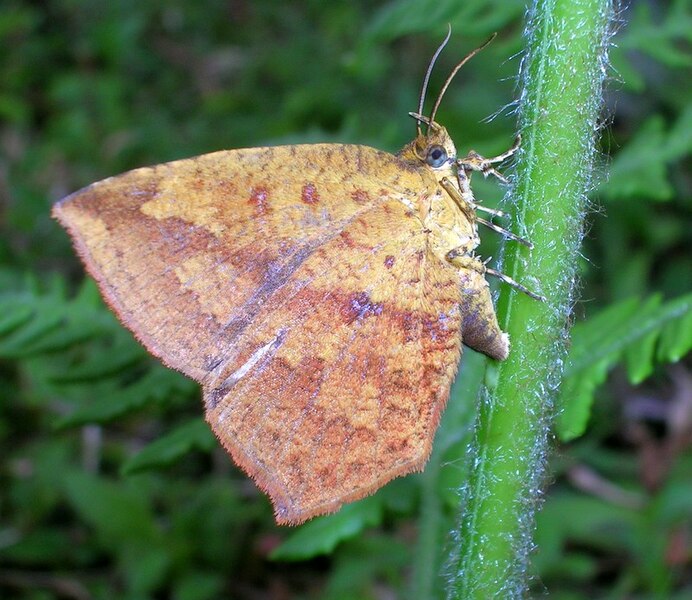There is a widespread idea that things herbal are automatically safe. This, unfortunately, is not quite true as plants have, in their long drawn war with their enemies evolved some deadly defences. Ferns are some of the older plant groups that are found on land today. On a trip to the Talakaveri area in Coorg, I noticed this butterfly-like moth sitting on a fern.
 |
| Tetragonus catamitus |
Although it holds its wings like a butterfly and is about the size of a typical Lycaenid, the antennae, the spines on the legs and the stout body give away its identity and it turned out to be
Tetragonus catamitus, a moth in the family Callidulidae. Almost all the moths in this family have their caterpillars feeding on ferns. The entire family has a rather restricted distribution in South Asia and Southeast Asia but extending somewhat oddly into Madagascar.
 |
| Callidulidae distribution from Grehan (1991) |
On the same trip, we went down to Bhagamandala to collect
Diplazium esculentum to cook a dish. This fern is widespread in Asia and young curly fronds are eaten across its range.
In northern India it is called linguda. The picked fronds are typically sauteed with some spices to make up the rather tasy dish.
Edible ferns are not as common as the bracken ferns of the genus
Pteridium, some of which are weeds. Their leaves have a protein called Ptaquiloside (PTA) that is carcinogenic and yet young fronds of this species are cooked and eaten in Japan where it may be contributing to a high incidence of gastic cancer. Heat causes ptaquiloside to lose its function as a toxin or anti-feedant. PTA has even been considered an environmental contaminant as it may leach from the fronds and enter water and soil and traces have even been found in milk from cattle fed on bracken infested pastures. The more edible ferns like
Diplazium have lower levels of PTA. Some ferns show a peculiar preference for arsenic, extracting it from soil and accumulating it in their leaves. Arsenic at high concentrations is toxic to most animals. Perhaps the younger fronds that are traditionally picked have a lower level of the toxin? Given the primitive vascular system, one might think that PTA is synthesized in the older leaves and retained there without being translocated into the young fronds. However this does not hold water as several studies have specifically looked at whether and how ferns translocate nutrients. The weedy
Pteridium is very tolerant to herbicides and studies have attempted to find the source of their resistance. It appears that they do not move the herbicide from the sprayed leaves to their rhizomes. So while herbicides cause leaf death, the rhizomes come back to life in the next rain. However other studies using radio-isotopes have found that sugars are translocated as in angiosperms and PTA concentrations actually tend to be higher in young fronds - where the need for protection from herbivores is greater.
 |
| Diplazium growing along a stream |
Now the number of insects that feed on ferns is something to think about. One estimate (Hendrix, 1980) put it at a mere 465 species (Hendrix however missed the Callidulidae in his list) ! The number of vertebrates feeding on fern spores is 3 [a mouse, the bullfinch (
Pyrrhula murina) and short-tailed bat (
Mystacina tuberculata)] Ferns are the oldest vascular land plants and given that very few of the extant herbivores feed on them, some authors have suggested that their defenses may have been overcome by herbivores of the past, especially the larger dinosaurs of the Carboniferous Period. Taggart and Cross (1997) note that herbivory is rather uncommon among extant reptiles. The mildest PTA symptoms include Thiamine deficiency and so a little searching for Thiamine deficiency in the nearest relatives of the dinosaurs, the birds, throws up the possibility that PTA was evolved as a defense against herbivorous dinosaurs. Thiamine deficiency in birds was something new to me and a paper on large scale declines in European birds due to it came as a bit of a surprise. I have heard of people getting sick from eating
Diplazium and it seems like one should be careful when it comes to eating ferns.
 |
| A fern leafminer |
Further reading
- Stephen D. Hendrix (1980) An Evolutionary and Ecological Perspective of the Insect Fauna of Ferns. The American Naturalist 115(2):171-196.
- R. Somvanshi, D. R. Lauren , B. L. Smith, R. K. Dawra , O. P. Sharma , V. K. Sharma, A. K. Singh and N. K. Gangwar (2006) Estimation of the fern toxin,ptaquiloside, in certain Indian ferns other than bracken. Current Science 91(11):1547-1552.
- Fatal fern (News report) - the full thesis
- Mouse feeding on fern spores
- Jeffrey T. Hutchinson, Kenneth A. Langeland, Gregory E. MacDonald, and Robert Querns (2010) Absorption and Translocation of Glyphosate, Metsulfuron, and Triclopyr in Old World Climbing Fern (Lygodium microphyllum). Weed Science, 58(2):118-125.
- Grehan JR (1991) A panbiogeographic perspective for pre-Cretaceous Angiosperm-Lepidoptera coevolution. Australian Systematic Botany 4:91-110.
- Labandeira C C (2006) The Four Phases of Plant-Arthropod Associations in Deep Time. Geologica Acta 4(4):409-438.
- Taggart RE and Aureal T Cross (1997) The relationship between land plant diversity and productivity and patterns of dinosaur herbivory. Dinofest International Proceedings.
- Lennart Balk, Per-Åke Hägerroth, Gun Åkerman, Marsha Hanson,Ulla Tjärnlund,Tomas Hansson, Gunnar Thor Hallgrimsson, Yngve Zebühr, Dag Broman, Torsten Mörner, and Henrik Sundberg (2009) Wild birds of declining European species are dying from a thiamine deficiency syndrome. PNAS 106 (29):12001-12006.



No comments:
Post a Comment